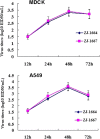Isolation and characterization of novel reassortant H6N1 avian influenza viruses from chickens in Eastern China
- PMID: 30355336
- PMCID: PMC6201551
- DOI: 10.1186/s12985-018-1063-y
Isolation and characterization of novel reassortant H6N1 avian influenza viruses from chickens in Eastern China
Abstract
Background: The H6N1 subtype of avian influenza viruses (AIVs) can infect people with an influenza-like illness; the H6N1 viruses possess the ability for zoonotic transmission from avians into mammals, and possibly pose a threat to human health.
Methods: In 2017, live poultry markets (LPMs) in Zhejiang Province were surveyed for AIVs. To better understand the genetic relationships between these strains from Eastern China and other AIVs, all gene segments of these strains were sequenced and compared with sequences available in GenBank. In this study, we analyzed the receptor-binding specificity, antigenic characteristics, and pathogenicity of these two H6N1 viruses.
Results: In 2017, two H6N1 AIVs were isolated from chickens during surveillance for AIVs in LPMs in Eastern China. Phylogenetic analysis showed that these strains shared genetic characteristics from H6, H10, H1, and H4 AIVs found in ducks and wild birds in East Asia. These AIV strains were able to replicate in mice without prior adaptation.
Conclusions: In this study, we report the discovery of new strains of H6N1 viruses from chickens with novel gene reassortments. Our results suggest that these chickens play an important role generating novel reassortments in AIVs, and emphasize the need for continued surveillance of AIV strains circulating in poultry.
Keywords: Avian influenza viruses; Chickens; Eastern China; Reassortant; Subtype H6N1.
Conflict of interest statement
Ethics approval
The animal experiments conducted in this study were approved by the First Affiliated Hospital, School of Medicine, Zhejiang University (No. 2015–15).
Consent for publication
Not applicable.
Competing interests
The authors declare that they have no competing interests.
Publisher’s Note
Springer Nature remains neutral with regard to jurisdictional claims in published maps and institutional affiliations.
Figures





Similar articles
-
Isolation and genetic characterization of novel reassortant H6N6 subtype avian influenza viruses isolated from chickens in eastern China.Arch Virol. 2016 Jul;161(7):1859-72. doi: 10.1007/s00705-016-2861-4. Epub 2016 Apr 21. Arch Virol. 2016. PMID: 27101069
-
Novel reassortant H10N7 avian influenza viruses isolated from chickens in Eastern China.J Clin Virol. 2015 Apr;65:58-61. doi: 10.1016/j.jcv.2015.02.007. Epub 2015 Feb 11. J Clin Virol. 2015. PMID: 25766990
-
Genetic characterization of natural reassortant H4 subtype avian influenza viruses isolated from domestic ducks in Zhejiang province in China from 2013 to 2014.Virus Genes. 2015 Dec;51(3):347-55. doi: 10.1007/s11262-015-1245-2. Epub 2015 Sep 9. Virus Genes. 2015. PMID: 26350888
-
Avian influenza in the Greater Mekong Subregion, 2003-2018.Infect Genet Evol. 2019 Oct;74:103920. doi: 10.1016/j.meegid.2019.103920. Epub 2019 Jun 13. Infect Genet Evol. 2019. PMID: 31201870 Review.
-
Global distribution, receptor binding, and cross-species transmission of H6 influenza viruses: risks and implications for humans.J Virol. 2023 Nov 30;97(11):e0137023. doi: 10.1128/jvi.01370-23. Epub 2023 Oct 25. J Virol. 2023. PMID: 37877722 Free PMC article. Review.
Cited by
-
Evolution and pathogenicity of H6 avian influenza viruses isolated from Southern China during 2011 to 2017 in mice and chickens.Sci Rep. 2020 Nov 25;10(1):20583. doi: 10.1038/s41598-020-76541-0. Sci Rep. 2020. PMID: 33239647 Free PMC article.
-
Immune Control of Avian Influenza Virus Infection and Its Vaccine Development.Vaccines (Basel). 2023 Mar 4;11(3):593. doi: 10.3390/vaccines11030593. Vaccines (Basel). 2023. PMID: 36992177 Free PMC article. Review.
-
Generation of neutralizing and non-neutralizing monoclonal antibodies against H7N9 influenza virus.Emerg Microbes Infect. 2020 Mar 20;9(1):664-675. doi: 10.1080/22221751.2020.1742076. eCollection 2020. Emerg Microbes Infect. 2020. PMID: 32193996 Free PMC article.
-
A multiplex TaqMan real-time RT-PCR assay for the simultaneous detection of H4, H6, and H10 avian influenza viruses.Heliyon. 2023 Apr 21;9(5):e15647. doi: 10.1016/j.heliyon.2023.e15647. eCollection 2023 May. Heliyon. 2023. PMID: 37153423 Free PMC article.
-
Genetic and virological characteristics of a reassortant avian influenza A H6N1 virus isolated from wild birds at a live-bird market in Egypt.Arch Virol. 2024 Apr 9;169(5):95. doi: 10.1007/s00705-024-06022-6. Arch Virol. 2024. PMID: 38594485
References
-
- Zhu X, Yu W, McBride R, Li Y, Chen LM, Donis RO, Tong S, Paulson JC, Wilson IA. Hemagglutinin homologue from H17N10 bat influenza virus exhibits divergent receptor-binding and pH-dependent fusion activities. Proc Natl Acad Sci U S A. 2013;110:1458–1463. doi: 10.1073/pnas.1218509110. - DOI - PMC - PubMed
Publication types
MeSH terms
Substances
Grants and funding
- 81502852/the National Science Foundation of the People's Republic of China/International
- 2017ZZ10 and 2018ZZ06/the Independent Task of State Key Laboratory for Diagnosis and Treatment of Infectious Diseases/International
- Y19H260021 and Y15H190006/Zhejiang Provincial Natural Science Foundation of China/International
LinkOut - more resources
Full Text Sources
Medical

